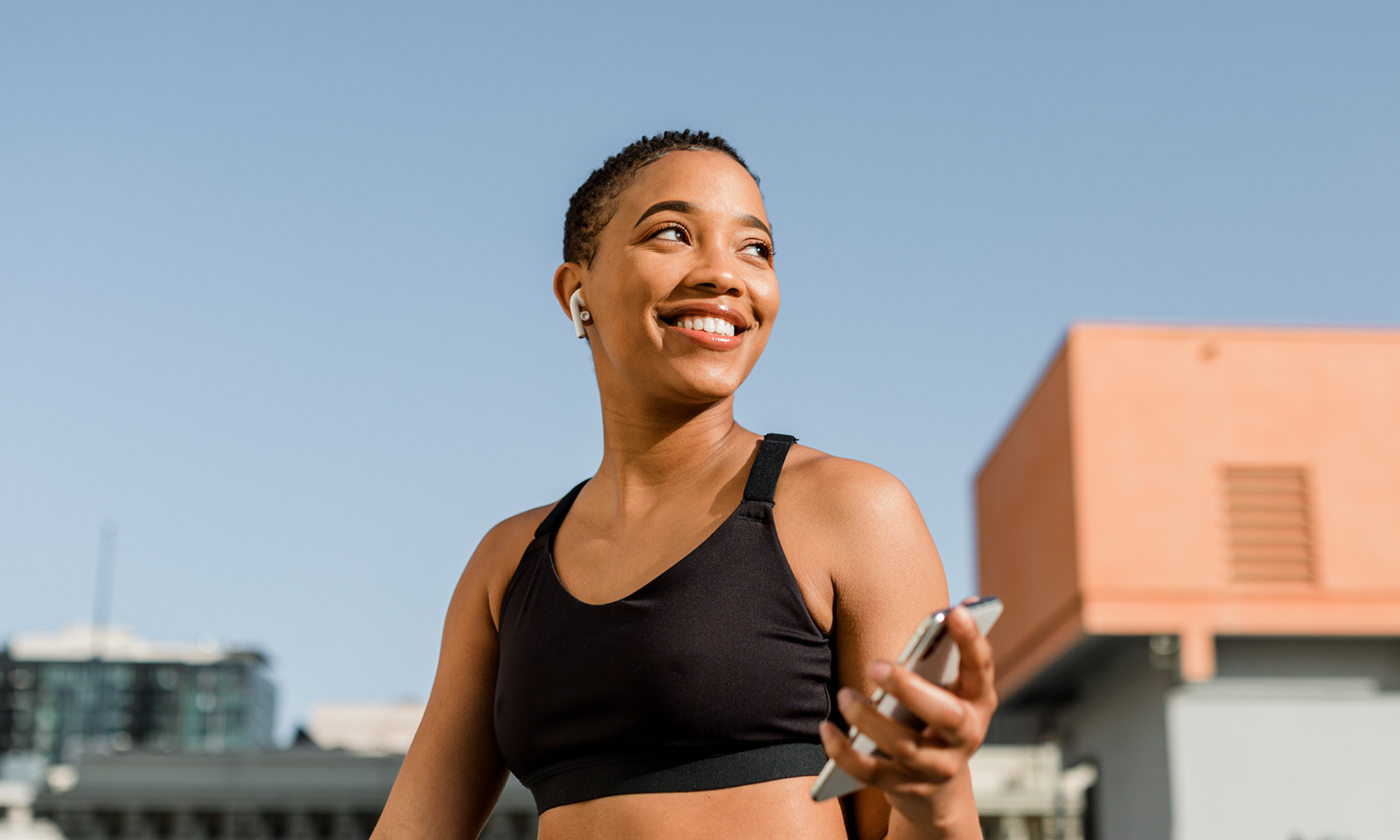Podiatrists Agree: This One Feature Is Crucial For Running Shoes
Support your arches; support your speed.
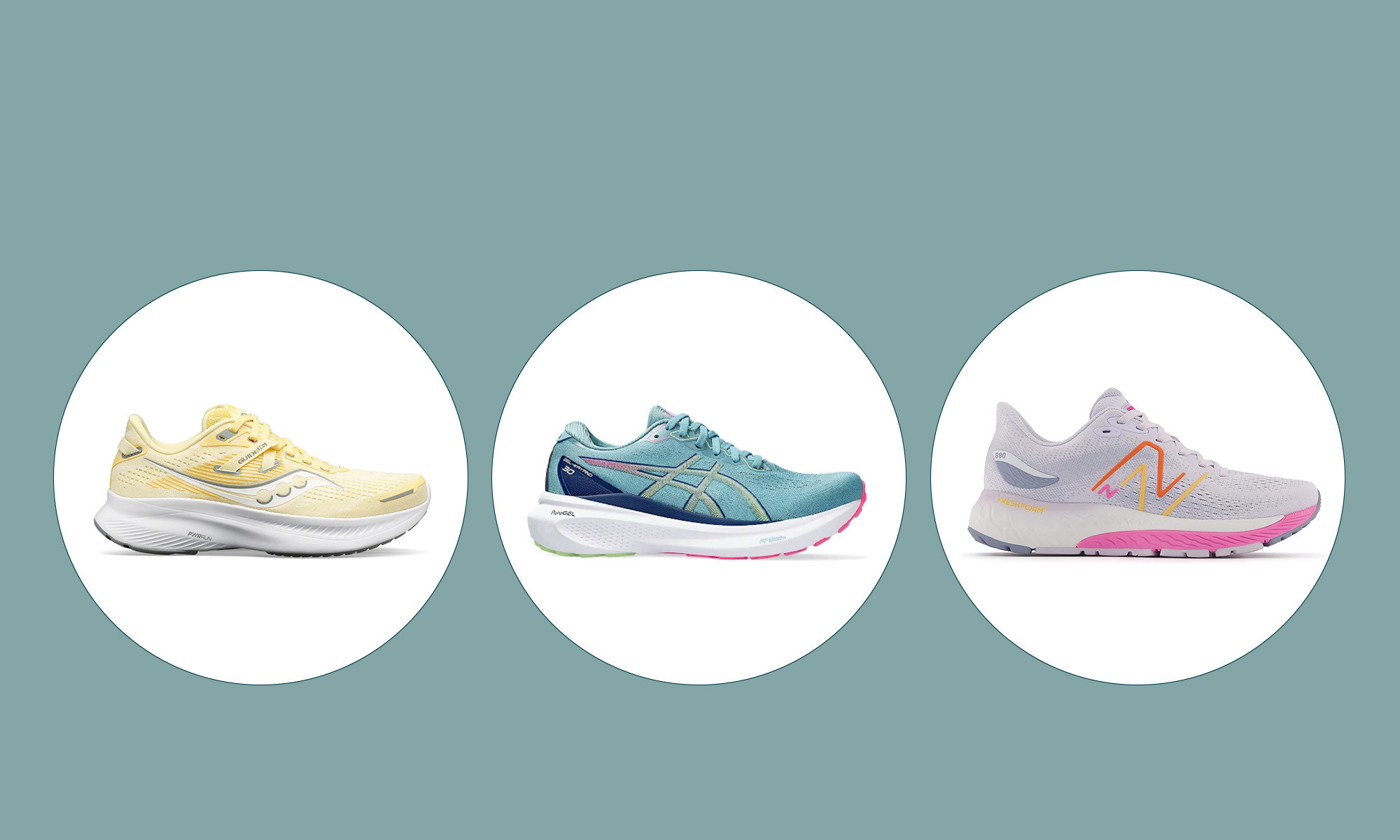
September 10, 2023 We carefully vet all products and services featured on mindbodygreen using our Our selections are never influenced by the commissions earned from our links. When it comes to running shoes, there's a lot more to consider than style and size. Long distance running shoes, for example, meet the unique demands of extended mileage and help maintain optimal foot and joint health—great for lessening your chance of muscle damage1. Similarly, the best running shoes for high arches are essential for those with (you guessed it) high arches, to provide the right amount of shock absorption and stability. Because running is a fantastic way to boost your mental health, cardiovascular health2, and longevity3, you don’t want to let your need for high arch support slow you down. Read on to discovery what to look for in your search for the best running shoes for high arches.
What is considered a high arch?
The arch of your foot is the curved area between the ball of your foot and the heel. While we all have a natural arch to our feet, the height of it can vary dramatically which is why some people are considered "flat-footed," meaning they have little to no noticeable arch.
According to the American College of Foot and Ankle Surgeons, a high arch (also known as "cavus foot") can be something in your genetics, a side effect of a neurological disorder or medical condition, or it can be developed over time.
Kornfeld says high arches are mostly congenital. “It has to do with the structure of the foot developed during the fetal stage," he explains. "Short plantar fascias, tight achilles tendons or calf muscles are the most common causes. There are also some patients with skeletal abnormalities within the foot itself.”
Per Kornfeld, when the angle between the heel bone (which sits at an incline and the forefoot which sits at a decline) is excessively high, it causes the foot to bear weight unevenly. “Many patients have an increase in stress in the forefoot right before propulsion and complain of pain in the metatarsal area (the ball of the foot). Because of the high angle, the extensor tendons gain an advantage and create hammertoe deformities.”
Put simply: Ignore your high arches and you could experience a few foot problems, like pain, ankle instability, and increased risk of sprains.
How high arches impact running
High arches can impact your ability to run any amount of distance regularly in many ways that impact performance and comfort.
“Since less weight is transferred through the midfoot with high arches, there is greater stress in the forefoot causing pain syndromes," Kornfeld says. "There are also patients who have an overly tight calf that can create stress on the achilles tendon and many have very short or tight plantar fascia that can also become stressed and painful.”
Here are a few other ways that having high arches impact running:
Less shock absorption: With higher arches, there is less natural shock absorption when the foot strikes the ground. This can lead to a higher risk of stress fractures, shin splints, and other overuse injuries, as the impact forces are not adequately absorbed.
Less natural pronation: Pronation is the natural inward rolling of the foot during the gait cycle, which helps with shock absorption and weight distribution. High arches often lead to underpronation (supination), where the foot doesn't roll inward enough. This can result in an uneven distribution of pressure, leading to discomfort and potential injuries.
Poor stability: High-arched feet are generally less stable than those with normal arches. Runners with high arches may have difficulty maintaining balance and stability, increasing the risk of ankle sprains and falls during their runs.
Limited flexibility: High arches can result in reduced flexibility in the foot's midsection, making it challenging to adapt to uneven terrain or absorb shock effectively. This can lead to a less efficient and more uncomfortable running experience.
"The majority of high-arched patients have a more rigid structure to their feet," says Kornfeld. "Rigid-type feet are generally less capable of absorbing stresses, as it's difficult for the foot to share and properly distribute weight."
To mitigate the impact of high arches on running, individuals with this foot type should consider wearing running shoes designed specifically for high arches, that provide the necessary support and cushioning. We always recommend consulting with a podiatrist for a thorough evaluation to address any specific issues related to high arches and running.
What to look for in running shoes for high arches
Good arch support: Of course, good arch support is a requirement. "Shoes should help bring the ground up to meet the midfoot, providing arch support" to help the foot properly distribute weight across its entire surface, Kornfeld explains.
Shock absorption: Sharkey says cushion is key, so you’ll want to look for neutral shoes or well-cushioned shoes. “High arched feet are less flexible and more rigid than flat feet, which translates into needing more shock absorption of the weight of activity occurring in the feet," she says.
Flexibility: If you have a more rigid foot, go for something more flexible. Kornfeld adds, “If the patient has a rigid type high arch foot, a more flexible shoe is helpful. For those with a flexible high arch, less flexibility is better. In both instances, good impact support is critical.”
How we picked:
Expert insight
Most of our picks are direct recommendations from the podiatrists we interviewed. Others were chosen by our team based on personal experience, our expert's guidelines, and additional research.
Design
We took our expert's recommendations to heart and focused on shoes that provide ample midfoot support, shock absorption, cushion, and flexibility (if you have a rigid high arch).
Quality
Each shoe we chose is made with durable materials that will last for extended periods of time, so you'll get more life out of your investment.
Price
We know everyone's budget is different—that's why we included a wide range of price points, with a few picks that are more budget-friendly.
Our picks of the best running shoes for high arches of 2023:
Best for wide feet: Brooks Ghost 15
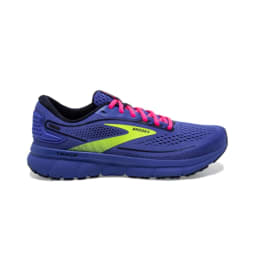
Pros:
Four width optionsContours to your footAPMA certifiedMaterials:
Semi-recycled materials
Sizes available:
5-13Half sizes availableWide sizes available
If you have high arches and wide feet, Sharkey says this pair is a top choice. It also earned the APMA Seal of Acceptance for its improved cushioning, smooth transitions, and enhanced upper which promotes foot health.
These shoes are available in medium (1B), wide (2E), extra wide (4E), and narrow (2A) sizes, so everyone can find the right fit.
Segmented crash pads deliver support and cushioning all around the foot for reduced impact. Plus, its 3D Fit Print upper and DNA BioMoGo actually conform to your foot for next-level stability and comfort.
Best for women: Asics Gel Nimbus 25
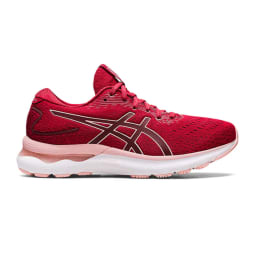
Pros:
Flexible and well-cushionedGreat for distance running and walkingBreathableCons:
Not great for wide feetMaterials:
Engineered meshBio-based celluloseNanofiber
Designed for under pronation that happens with high arches, the Gel Nimbus assists with push off by providing pressure on the smaller toes on outside of foot to mitigate injuries such as plantar fasciitis, shin splints, and ankle strain.
Both podiatrists we spoke with recommend this pick for runners with high arches. Kornfeld says, “When additional plush cushioning is needed, the Asics Gel Nimbus 25 is a good choice. They are very comfortable, stable and light in spite of the extra-cushioning.”
Mindbodygreen's very own marathon-running commerce editor, Carleigh Ferrante, also swears by the Asics Gel Nimbus. In fact, it’s been her tried and true shoe for years and they are the only shoes she's trusted for marathon running.
“Despite every modification and change, the Gel Nimbus continues to hold up—and I'm constantly impressed,” she says. “They're designed for long or short runs (or even walking), so they can be worn for sprints, distance runs, and everything in between.”
Advertisement
This ad is displayed using third party content and we do not control its accessibility features.
Best for plantar fasciitis: Hoka Gaviota 5
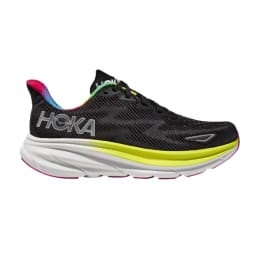
Pros:
APMA CertifiedCushy midsole with ankle stabilityWide sizes available in 3 colorwaysMaterials:
Recycled polyesterRecycled nylonRubber
Sharkey says this pick is an excellent option for extra ankle stability and cushion. While not overly cushy, these shoes offer two more millimeters of foam than the brand's previous model, making them a soft, stable, and balanced running shoe that can help prevent plantar fasciitis.
The new stabilizing H-Frame™ has even softer foams than before, delivering maximum stability without compromising cushioning. If you’re a fan of the Hoka Bondi, you can expect that same Bondi-level cushioning to deliver that signature HOKA ride.
Best for stability: Brooks Adrenaline GTS
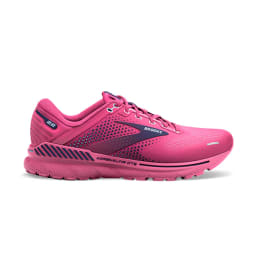
Pros:
Orthotic-friendlyAPMA seal of acceptanceAffordable price pointCons:
Shorter lacesMixed reviews about durabilityMaterials:
Recycled materials
Sharkey recommends this shoe specifically for added stability. It’s a great choice for runners of all levels, including those with knee pain, with patented GuideRails technology to keep your foot in alignment, offering a solid balance of support and cushion.
This shoe specifically uses recycled materials, such as plastic water bottles—and the company has plans to achieve net zero carbon emissions by 2040.
Advertisement
This ad is displayed using third party content and we do not control its accessibility features.
Best for shock absorption: Hoka Bondi 8
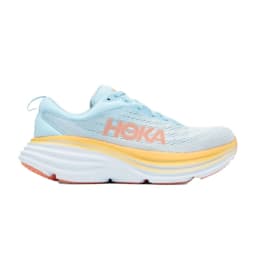
Pros:
Super cushy and breathableAvailable in wideAPMA approvedMaterials:
Recycled polyesterRubber
Sizes available:
5-12Half sizes available
This is Hoka's most cushioned shoe—and each podiatrist we spoke with agree that the Hoka Bondi is a solid choice, whether you have high arches or not.
Sharkey says, “The Hoka Bondi 8’s are one of my favorite shock absorbing shoes.” You can expect tons of bounce from this shoe as the tall stack height is designed to absorb impact with every step while keeping you light on your feet.
The Bondi 8 is a breathable shoe with neutral support and a memory foam ankle cradle. Like most of Hoka’s sneakers, they are approved by the American Podiatric Medical Association (APMA), meaning they’re promoted by podiatrists as being beneficial for foot health.
Best for racing : ASICS Metaspeed Sky+
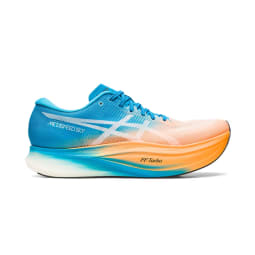
Pros:
Well cushionedEnergetic midsole foamAt least 20% of the upper's material is made with recycled polyesterMaterials:
Some recycled polyester
Sizes available:
5-12.5Half sizes availableWide sizes available
If you want to be fast on your feet, Kornfeld recommends the Asics Metaspeed Sky+. “It's a fast shoe. There’s plenty of protective cushioning and stable when cornering,” he says.
Marathon racers with high arches appreciate the midsole technology and sidewall geometry in the forefoot, designed to provide a more propulsive toe-off.
Plus, its thick stack of cushioning improves compression and creates a responsive feel underfoot. If your feet get hot during races, you'll love the shoe's breathable mesh upper.
Advertisement
This ad is displayed using third party content and we do not control its accessibility features.
Best flexibility: Saucony Endorphin Speed 3
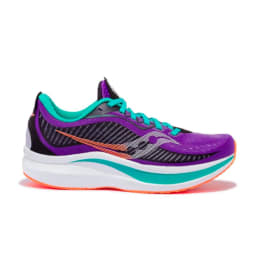
Pros:
Sustainable choiceAPMA certifiedMax cushioningMaterials:
VeganRecycled materials
Sizes available:
5-12Half sizes availableWide sizes available
Many people with high arches have a rigid type high arch and will benefit from a flexible running shoe, according to our experts. This is Kornfeld’s number one recommendation for a flexible running shoe for high arches.
“If a patient has a rigid type high arch foot, a more flexible shoe is helpful and will do well with a neutral, well-cushioned shoe.”
There’s plenty to love about this shoe's design. It gives you a snappy, on your toes feeling, with a thick stack of foam cushioning that’s perfect for fast tempo training and races.
Kornfeld says he loves this shoe because it’s “stable, has a breathable upper, and it’s lightweight.” Of course, we love that this style is APMA certified, signaling that it is promotional of foot health by podiatrists.
Plus, it’s made with vegan and recycled materials so you can feel good about what’s on your feet.
Best podiatrist-recommended: Puma Deviate Nitro II
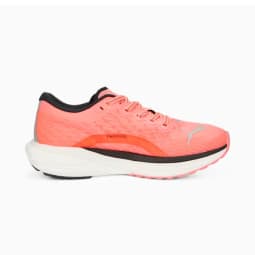
Pros:
Breathable mesh upperTPU heel spoilerLightweight feel with great cushioningCons:
Limited wide sizes availableMaterials:
Deviate NITRO™️ 2NITRO™️ Elite foam
This one's a top recommendation from Kornfeld. He says, “It’s a perfect shoe for runners with high arches, with its cushioned forefoot and predictable fit.”
We also reference this Puma best-seller at length in our article on how to run with less pain. It has even more responsive cushioning than its award-winning predecessor, the Deviate NITRO™️—and this latest model features a full-length layer of premium NITRO™️ Elite foam at the midsole for supreme cushioning and peak propulsion.
It also has great stability, cushioning, and responsiveness that high arches require for running, all in a lightweight package. With an engineered plate to propel you forward even faster, this could be key for your next personal record.
Advertisement
This ad is displayed using third party content and we do not control its accessibility features.
Best for road running: Saucony Guide 16
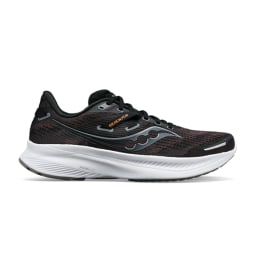
Pros:
FlexibleContours to your footAPMA certifiedMaterials:
VeganRecycled materials
Sizes available:
5-12Half sizes availableWide sizes available
This APMA certified flexible running shoe comes recommended by Kornfeld for those who have a rigid type high arch foot. Guidance rails support your foot from heel to toe—and wide sizes are available, too.
The midsole is lighter than previous generations of the brand's model but still gives plenty of cushioning in the midsole, which Kornfeld says is important for those with high arches. While this is a great shoe for wide feet, the Guide 15 is slightly slimmer than the Guide 14.
Comparing the best running shoes for high arches
How running impacts our health and longevity
Running offers many physical, mental, and well-being benefits. As you’ve likely heard, it’s an excellent way to improve cardiovascular health and strengthen muscles—but did you know running can also help improve quality of sleep4, longevity5, and mental health6?
Sharkey says, "Exercise improves mental health. Exercise also improves cardiovascular health. Anything that positively impacts our health will ultimately impact the longevity and quality of life we experience."
One study concluded regular exercise can improve life expectancy up to almost 7 years5. So if you are on a journey to increase your well-being and quality of life, running can be a great way to take care of yourself from the inside out.
FAQ:
What kind of running shoes do I need if I have high arches?
Holistic podiatrist Robert Kornfeld says running shoes with good arch support are a requirement. In addition, if you have a rigid type high arch foot, a more flexible shoe is helpful.
For those with a flexible high arch, less flexibility is better. In both instances, good impact support is critical.
Do high arches need more or less support?
Podiatrists agree that good midfoot arch support is a requirement.
Is it harder to run with high arches?
Kornfeld says high arched feet do very well with sprinting. “For long distance running, they can develop functional challenges. In those patients, a podiatrist can assess the need for custom-molded orthotics or a change in running shoes.”
What causes high arches?
Kornfeld says high arches are mostly congenital. “It has to do with the structure of the foot developed during the fetal stage. Short plantar fascias, tight achilles tendons or calf muscles are the most common causes. There are also some patients with skeletal abnormalities within the foot itself.”
Are stability or neutral shoes better for high arches?
Sharkey says that neutral shoes or cushioning shoes work for high arches depending on your specific foot type. High arched feet are less flexible and more rigid than flat feet and this translates into more of the shock absorption of the weight of activity occurring in the feet.
The takeaway
The best running shoes for high arches can make or break your comfort and performance. Just remember: If you have high arches, running shoes aren’t the only shoe style where you’ll need support. Check out our roundup of the best walking shoes for high arches, according to podiatrist guidelines, so you can keep your feet healthy and safe through all activities.

 JaneWalter
JaneWalter 












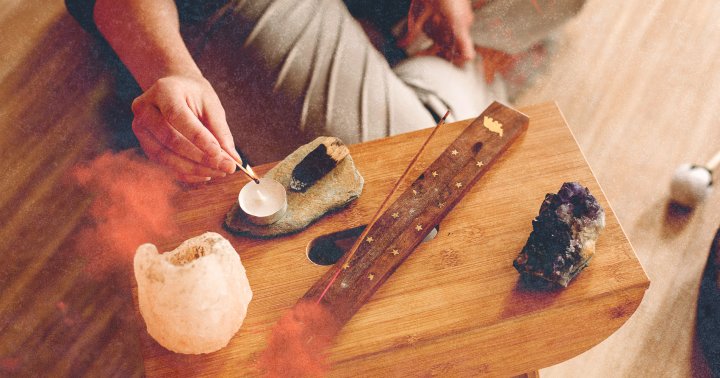












.jpg)







